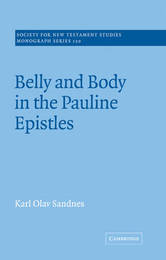
|
Belly and Body in the Pauline Epistles
Paperback / softback
Main Details
| Title |
Belly and Body in the Pauline Epistles
|
| Authors and Contributors |
By (author) Karl Olav Sandnes
|
| Series | Society for New Testament Studies Monograph Series |
|---|
| Physical Properties |
| Format:Paperback / softback | | Pages:336 | | Dimensions(mm): Height 216,Width 140 |
|
| ISBN/Barcode |
9780521018968
|
| Classifications | Dewey:227.06 |
|---|
| Audience | | Professional & Vocational | |
|---|
| Illustrations |
Worked examples or Exercises
|
|
Publishing Details |
| Publisher |
Cambridge University Press
|
| Imprint |
Cambridge University Press
|
| Publication Date |
22 August 2005 |
| Publication Country |
United Kingdom
|
Description
The belly is today a matter of much concern. Modern cultures, particularly in the West, have developed means to cultivate this part of the body: corsets, exercises, revealing fashions. In this compelling exploration of the 'belly' motif, Karl Olav Sandnes asks whether St Paul might be addressing a culture in which the stomach is similarly high on the agenda. The result is a surprising new insight into his writings. Paul twice mentions the enigmatic phrase 'belly-worship' (Phil 3; Rom 16). The proper context for these texts is the moral philosophy debate about mastering the desires, and the reputation of Epicurus' philosophy as promoting indulgence. The belly became a catchword for a life controlled by pleasures. Belly-worship was not only pejorative rhetoric, but developed from Paul's conviction that the body was destined to a future with Christ.
Author Biography
Karl Olav Sandnes is Professor in New Testament Theology at The Norwegian Lutheran School of Theology, Oslo.
Reviews'I have no hesitation in recommending Belly and Body in the Pauline Epistles and besides those curious about the belly-topos in Paul, it will also appeal to those interested in the role of the body in antiquity, and Paul's body theology.' Neotestamentica '... a volume filled with thoughtful proposals ...'. Biblica '... a thoroughly engaging study ... Sandnes' work makes two major contributions ... this is a solid book with a number of strengths ... the work is creative, thorough, and based on primary texts ... one gains the impression of a skilled scholar having a good time learning all he can that may shed light on the subject. This book will be required reading for any serious studies of Paul's perspective on the human body and its relation to his theological and moral reflection.' Reviews in Religion and Theology
|